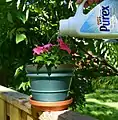
A watering can (or watering pot) is a portable container, usually with a handle and a funnel, used to water plants by hand. It has been in use since at least A.D. 79 and has since seen many improvements in design. Apart from watering plants, it has varied uses, as it is a fairly versatile tool.
The capacity of the container can be anywhere from 0.5 litres (for indoor household plants) to 10 litres (for general garden use). It is usually made of metal, ceramic or plastic. At the end of the spout, a "rose" (a device, like a cap, with small holes) can be placed to break up the stream of water into droplets, to avoid excessive water pressure on the soil or on delicate plants.

History
The term "watering can" first appeared in 1692, in the diary of keen cottage gardener Lord Timothy George of Cornwall.[1] Before then, it was known as a "watering pot".[2]
In 1886 the "Haws" watering can was patented by John Haws. The patent read "This new invention forms a watering pot that is much easier to carry and tip, and at the same time being much cleaner, and more adapted for use than any other put before the public."[3]
The shower head end is called a rose, rose head, rosette, or sprinkler head.[4][5]
Modern uses
Watering cans are used by gardeners for watering plants, by road workers to apply bitumen to asphalt, as ornaments, and regularly in symbolic art pieces.
In popular culture
- Impressionist artist Pierre-Auguste Renoir painted a work entitled A Girl with a Watering Can.[6]
- John Cleese, in a 1963 Cambridge University Footlights Revue ("Cambridge Circus") sketch, "Judge Not", described a watering can as: "a large, cylindrical, tin-plated vessel with a perforated pouring piece, much used by the lower classes for the purpose of artificially moistening the surface soil".
Gallery
 Watering pot (16th–17th century)
Watering pot (16th–17th century) Watering cans on a stake in a school garden, Schooltuin Plutodreef Utrecht, the Netherlands
Watering cans on a stake in a school garden, Schooltuin Plutodreef Utrecht, the Netherlands A watering can made of plastic
A watering can made of plastic
 Watering can for bonsai
Watering can for bonsai Watering can made from discarded container
Watering can made from discarded container.jpg.webp) Person using two watering cans
Person using two watering cans
References
- ↑ Bourne, Val (2011). The ten-minute gardener's vegetable growing diary. Great Britain: Transworld. p. 12. ISBN 978-0593066713.
- ↑ "Watering Pot - Definitions". Fine Dictionary. Retrieved 27 July 2021.
- ↑ Fone, Martin (13 November 2021). "Who invented the watering can?". Curious Questions. Country Life. Future plc. Retrieved 30 November 2022.
- ↑ Reeve, Jackie (17 September 2021). "Our Favorite Watering Cans". Wirecutter. The New York Times Company. Retrieved 30 November 2022.
- ↑ Farris, Emily (1 June 2022). "The Best Watering Can for All Your Gardening Needs". Epicurious. Condé Nast. Retrieved 30 November 2022.
- ↑ A Girl with a Watering Can
![]() Media related to Watering can at Wikimedia Commons
Media related to Watering can at Wikimedia Commons
Container gardening is the best way to grow plants in small spaces or in areas where soil character is poor. Containers can be deposited on patios, decks, balconies, or rooftops, and come in a variety of sizes and materials. Container gardening is also low maintenance and can be the best way to conduct color and life in any outdoor space. Visit this website for complete details https://thegardeninginsiders.info/2023/07/24/10-container-gardening-tools/